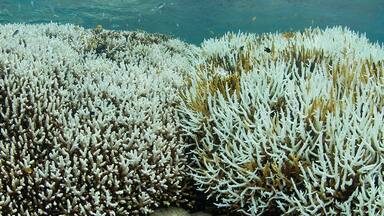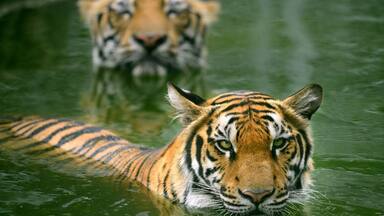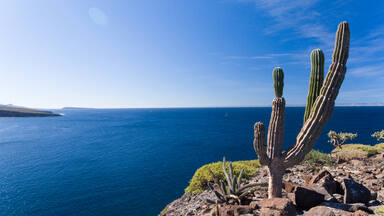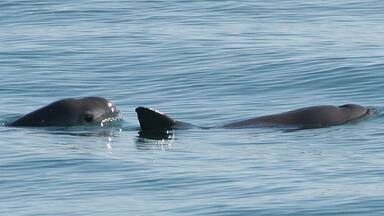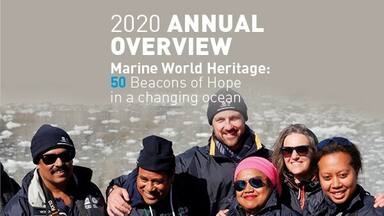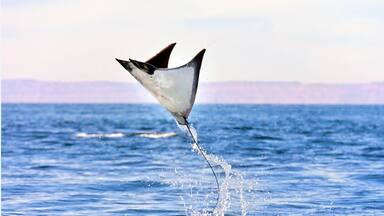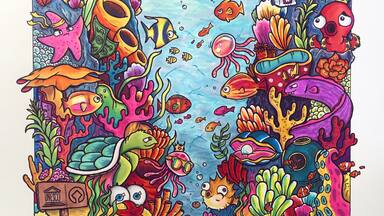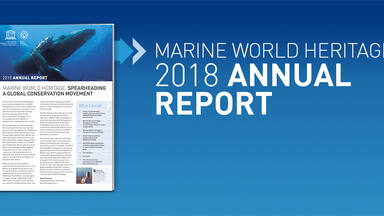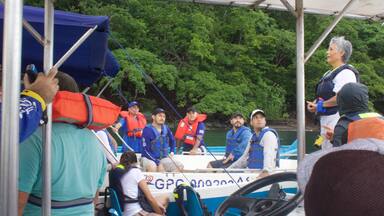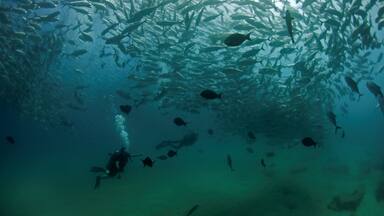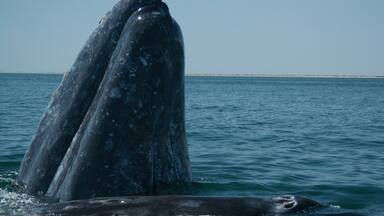Islands and Protected Areas of the Gulf of California
Islands and Protected Areas of the Gulf of California
The site comprises 244 islands, islets and coastal areas that are located in the Gulf of California in north-eastern Mexico. The Sea of Cortez and its islands have been called a natural laboratory for the investigation of speciation. Moreover, almost all major oceanographic processes occurring in the planet’s oceans are present in the property, giving it extraordinary importance for study. The site is one of striking natural beauty in a dramatic setting formed by rugged islands with high cliffs and sandy beaches, which contrast with the brilliant reflection from the desert and the surrounding turquoise waters. It is home to 695 vascular plant species, more than in any marine and insular property on the World Heritage List. Equally exceptional is the number of fish species: 891, 90 of them endemic. The site, moreover, contains 39% of the world’s total number of species of marine mammals and a third of the world’s marine cetacean species.
Description is available under license CC-BY-SA IGO 3.0
Îles et aires protégées du Golfe de Californie
Le site comprend 244 îles, îlots et zones côtières situées dans le golfe de Californie au nord-est du Mexique. La mer de Cortez et ses îles sont considérées comme un laboratoire naturel pour la recherche en matière de spéciation. De plus, presque tous les grands processus océanographiques à l’œuvre dans les océans de la planète sont représentés sur le site, lui donnant une importance sans commune mesure pour l’étude. Le site est d’une beauté naturelle remarquable et offre un paysage spectaculaire d’îles au relief accidenté composé de hautes falaises et de plages de sable, qui contrastent avec le cadre désertique qui s’y reflète et les eaux environnantes turquoise. Le site abrite 695 espèces de plantes vasculaires, plus que dans tout autre site marin et insulaire de la Liste du patrimoine mondial. Il est également exceptionnel du point de vue du nombre d’espèces de poissons : 891, dont 90 endémiques. De plus, le site héberge 39 % du nombre total d’espèces de mammifères marins et un tiers du nombre total des espèces de cétacés de la Terre.
Description is available under license CC-BY-SA IGO 3.0
جزر ومجالات محمية في خليج كاليفورنيا
ÙŠØوي الموقع 244 جزيرة وجزيرة صغيرة ومناطق ساØلية تقع ÙÙŠ خليج كاليÙورنيا شمال شرق المكسيك. ويÙعتبر بØر كورتس وجزره كمختبر طبيعي للبØØ« ÙÙŠ مجال نشوء الأنواع وتطورها. كذلك Ùإن التØولات الكبرى جميعها القائمة ÙÙŠ المØيطات على مستوى الكوكب ممثّلة ÙÙŠ الموقع، ممّا يمنØÙ‡ أهميّةً لا تقارَن لأغراض البØØ«. يتّسم الموقع بجمال٠طبيعي لاÙت٠ويوÙّر منظراً استثنائيًا من الجزر ذات التضاريس الوعرة والمؤلّÙØ© من الشواطئ الصخريّة والصخور المرتÙعة والشواطئ الرملية المتباينة مع السياق الصØراوي الذي تنعكس Ùيه، والمياه المجاورة ذات اللون الأزرق الÙيروزي. يضمّ الموقع 695 نوعًا من النبات القنوي، أي أكثر من أي موقع بØري آخر ضمن قائمة التراث العالمي. كما أنّه يتّسم بطابع استثنائي من Øيث عدد أنواع الأسماك، ويبلغ 891 نوعًا، منها 90 نوعًا مستوطÙنًا. كذلك Ùإن الموقع يأوي 39% من إجمالي عدد أنواع الثدييات البØرية وثلث إجمالي عدد أنواع الØيتان على الأرض.
source: UNESCO/CPE
Description is available under license CC-BY-SA IGO 3.0
加利福尼亚湾群岛及保护区
source: UNESCO/CPE
Description is available under license CC-BY-SA IGO 3.0
Острова и охраняемые природные территории в районе Калифорнийского залива
Объект, располагающийся на северо-западе Мексики, включает 244 островов, островков и отрезков побережья Калифорнийского залива, сосредоточенных в пределах 9 парков и резерватов. Калифорнийский залив и его острова - это общепризнанная естественная научная лаборатория по изучению процессов видообразования. В этом районе можно наблюдать практически все основные океанографические явления, происходящие в разных океанах нашей планеты, что делает залив еще более ценным с научной точки зрения. Скалистые острова с высокими утесами и песчаными пляжами резко контрастируют с отражением в бирюзовых морских водах пустынь, покрывающих сушу, что создает чрезвычайно живописный пейзаж. Здесь отмечено 695 видов сосудистых растений, что больше, чем на любом другом объекте Всемирного наследия, как морском, так и наземном. Исключительно разнообразны рыбы - 891 вид, включая 90 эндемических видов. В заливе зафиксировано 39 % общемирового числа видов морских млекопитающих, и примерно треть общемирового числа видов морских китообразных.
source: UNESCO/CPE
Description is available under license CC-BY-SA IGO 3.0
Islas y áreas protegidas del Golfo de California
Este sitio del noroeste de México abarca 244 islas, islotes y zonas litorales del golfo de California. El Mar de Cortés y sus islas son un laboratorio natural para el estudio de la especiación y el conocimiento de los procesos de evolución oceánicos y costeros, ya que casi todos ellos se dan en sus parajes. El sitio inscrito es de una excepcional belleza y ofrece a la vista paisajes espectaculares, en los que la cegadora luz del desierto y el color turquesa de las aguas hacen resaltar los acantilados escarpados de las islas y las playas de arena. Alberga además 695 especies botánicas y 891 ictiológicas, de las cuales 90 son endémicas. El número de especies vegetales es muy superior al registrado en los demás sitios insulares y marinos inscritos en la Lista del Patrimonio Mundial. Asimismo, este sitio alberga el 39% y el 33% del total mundial de las especies de mamíferos marinos y de cetáceos, respectivamente.
source: UNESCO/CPE
Description is available under license CC-BY-SA IGO 3.0
カリフォルニア湾の島々と保護地域群
登録地は、メキシコ北東部に位置するカルフォルニア湾に浮かぶ244の島々や海岸など9つの保護地域を含み、登録面積184万haのうち、138万haが海域である。かつて植物学者のジョージ・リンゼーが、「コルテス海とその島々は種形成の自然の実験室だ」と述べたように、この登録地には地球上に見られるほぼすべての海洋学的プロセスが存在し、海洋・沿岸の研究に重要な場所である。また、この地域で見られる891種の魚類のうち90種は固有種であり、世界中の海洋哺乳類種の39種%、クジラ類の3分の1の種が生息している。source: NFUAJ
Eilanden en beschermde gebieden van de Golf van Californië
Dit gebied bestaat uit 244 eilanden, eilandjes en kustgebieden aan de Golf van Californië in het noordoosten van Mexico. De Zee van Cortez en z’n eilanden worden wel een natuurlijk laboratorium voor het onderzoek naar soortvorming genoemd. Bijna alle grote oceanografische processen die zich voordoen in oceanen zijn aanwezig in dit gebied, waardoor het van buitengewoon belang is voor studie hiernaar. Het gebied is erg mooi dankzij ruige eilanden met hoge kliffen en zandstranden, die contrasteren met de weerspiegeling van de woestijn en de omliggende turkooizen wateren. De plek is de thuisbasis van 695 soorten vaatplanten en 891 vissoorten, waarvan er 90 inheems zijn. De site bevat bovendien 39% van het totale wereldwijde aantal soorten mariene zoogdieren en een derde van de 's werelds walvisachtigen.
Source: unesco.nl
Outstanding Universal Value
Brief synthesis
The Gulf of California in Northwestern Mexico, once famously dubbed the "Aquarium of the World", is recognized as an area of global marine conservation significance. Less known but equally spectacular are the terrestrial conservation values of the islands and coastal areas most of which are part of the Sonoran Desert. As a serial property, Islands and Protected Areas of the Gulf of California includes representative components of all major oceanographic zones of the biogeographically diverse Gulf, thereby capturing a broad spectrum of landscapes and conservation values. Extending from the Colorado River Delta in the north to 270 kilometres southeast of the tip of the Baja California Peninsula, the property includes 244 islands and islets clustered in eight major groups and another nine protected areas with coastal and marine zones. The total area is 1,837,194 hectares, of which about one quarter are terrestrial and the remainder marine.
The rugged islands and coastal desert contrasting with the surrounding turquoise waters are of striking natural beauty. Speciation both on land in the many islands and in the Gulf has resulted in a notable diversity of life forms with a high degree of endemism. The productivity of the Gulf also leads an extraordinary natural abundance of many marine species. There are some 900 species of fish, around 90 of them endemic, and roughly one third of the World's marine mammals occur within the property. The islands and islets are mostly of volcanic origin. There are numerous species of succulents, including some of the World's tallest cacti, exceeding 25 meters in height. Overall, some 700 species of vascular plants have been recorded. There are many species and impressive numbers of resident and migratory birds with some small islands hosting major proportions of the global population of Heermann's Gulls, Blue-footed Booby and Black Storm Petrel.
Criterion (vii): The serial property is of stunning landscape beauty with dramatic contrasts between the rugged and seemingly inhospitable islands, coastal deserts and the brilliant reflection from the surrounding turquoise waters. High rocky cliffs and sandy beaches in countless forms and colours rim the islands and coasts. The beauty of the desert landscape is complemented by the fascinating and highly diverse desert vegetation and the ubiquitous birds. To the south, the islands are covered with deciduous vegetation and stand out from the vast blue sea. The diversity and abundance of marine life associated with spectacular submarine terrain and unusual water transparency turn the underwater seascape into a globally renowned diver’s paradise.
Criterion (ix): A major foundation of the Gulf of California's phenomenal marine productivity are nutrient-rich upwelling oceanic currents supporting abundant phytoplankton and zooplankton, which in turn provide nurseries for larval reef fish. However, many other oceanographic processes, such as wind-driven currents, tidal mixing and thermohaline circulation, occur in the property, giving it extraordinary importance for conservation and the study of marine and coastal processes. The Gulf of California is notable for containing ecologically distinct bridge islands, populated across past land bridges, and oceanic islands populated by sea and air. The multitude and diversity of islands in terms of origin, size, environmental conditions and distance to the mainland has enabled an ongoing evolutionary speciation and endemism of major significance for conservation and science. The many components of the property are both part of a vast landscape and distinctive in many ways, ranging from a variety of pelagic and benthic environments to coral reefs, as well as mudflats, coastal wetlands and various types of desert and deciduous forest.
Criterion (x): The diversity of terrestrial and marine life in the property is extraordinary and constitutes a global priority for biodiversity conservation. On land, the close to 700 species of vascular plants are notable within a desert environment. There are 115 species of reptiles, almost half of them endemic, in some cases even to individual islands. 154 land bird species have been recorded and the property is of particular importance to migratory species. Almost 900 species of fish have been documented with some 90 species occurring exclusively in the Gulf of California or parts of it. These include the critically endangered species Black Sea Bass and Totoaba, as well as the vulnerable Basking Shark. The serial property provides habitat for roughly one third of the world’s total number of marine mammals, sometimes in impressive numbers, for example huge colonies of California Sea Lion. The five species of dolphin include the critically endangered Gulf Porpoise or "Vaquita". Eleven species of whale visit the northern Gulf, such as the endangered Blue Whale and Fin Whale and the vulnerable Sperm Whale. The coral reef at Cabo Pulmo is one of the most important in the Gulf of California and in the eastern Pacific. The marine habitats also harbour large concentrations of macro-invertebrate life with many endemic species, especially in the intertidal zones.
Integrity
All of the marine area and most of the 244 islands of the serial property are federally owned with only very few in private hands. Private owners typically do not live on the islands and the majority of the islands have no inhabitants, with some containing small settlements and camps of fishermen. Isla Maria Madre has been a state penitentiary since 1905. One particularity is the uninhabited Isla Tiburon (Shark Island), which is communally owned by the Seri indigenous peoples. The Seri consider the island a sacred site and carry out ceremonies. Overall, the past human impacts on land, for example from guano extraction and egg collection, are moderate. The serial approach is an adequate reflection of the biogeographic range and diversity of the Gulf of California and its islands. The great challenges to the integrity of the marine and coastal areas mostly stem from developments outside the protected areas, most importantly excessive fisheries, tourism and coastal development. Further extensions, including of vulnerable coastal areas and additional islands is an explicit element of the regional conservation strategy and would help consolidate the integrity of the property and the entire Gulf of California.
Protection and management requirements
The vast serial property has a step-wise formal conservation history going back at least to the 1950s. All of the islands within the property have a formal protection status under Mexican environmental legislation. While all of the marine area and most of the islands are federally owned, even the privately owned islands are bound to conservation and management requirements determined for each protected area at the time of its declaration and refined in management plans. All islands are protected and managed by the National Commission for Natural Protected Areas (CONANP), a specialized agency of the Mexican Ministry of the Environment and Natural Resources cooperating with several other involved governmental agencies. CONANP being a decentralized agency, management activities are implemented by the pertinent regional branch and their local operational units. Conservation, management and research are financially and technically supported by a number of local, national and international non-governmental organisations. There is an Integrated Management Program guiding conservation and management activities in the entire serial property and co-management arrangements with local communities are sought. Major challenges in the operational management are the securing of long-term funding, as well as coordination and cooperation across five different states and differing formal conservation status of components.
The coasts of the Gulf of California and the larger islands close to the shore were historically settled before imported diseases severely decimated the indigenous cultures. More recently, guano and egg collection, hunting of sea lions and whaling occurred in the Gulf of California. Most such activities have long been phased out leaving the affected areas to recover naturally. Threats today include, on land, alien invasive species with herbivores and predators menacing the delicate small island systems. The biggest, ongoing impact on the marine conservation values stems from artisanal, industrial and sport fishing. Fisheries and shrimp trawling play an important role in the local economy but put ever more pressure on the resources. Management responses are needed to ensure that harvesting levels are adapted to the productivity in the entire Gulf. Looming potential threats include plans for large-scale tourism development. While adapted forms of tourism can have important benefits in terms of awareness-raising and conservation funding, some proposed projects appear incompatible with long-term conservation and local development objectives. From the coasts pollution from agriculture, industry and sewage are increasing. The Gulf of California is a global conservation gem, invaluable to science and as a resource for local economic development, namely fisheries and tourism. Investing in the property's conservation is an investment in the maintenance of its productivity and economic potential.


